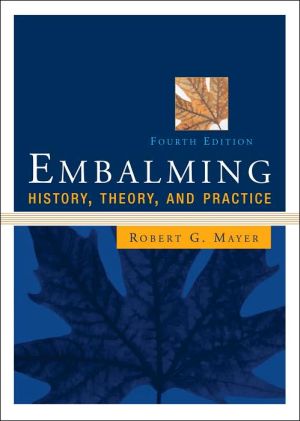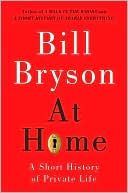Embalming: History, Theory, and Practice, Fourth Edition
There is no other book on the subject that is as complete and up-to-date in its coverage of the art and science of embalming, restorative arts, and mortuary cosmetology for students and practitioners. Known throughout the industry as the authority and complete reference on the history, theory, practice, and technique of embalming, this new Fourth Edition represents a thorough guide to traditional practice as well as new trends.
Search in google:
The basic textbook for mortuary science students and reference for practitioners, incorporates the curriculum and glossary of the American Board of Funeral Service Education for embalming and restorative art basic courses. It covers restorative art and mortuary cosmetology as well as embalming. The final 80 pages are selected readings. A glossary without pronunciation guides is included. No publisher is noted for the 1987 first edition; the 1990 and 1996 editions were published by Appleton and Lange. Annotation © 2006 Book News, Inc., Portland, OR The Director Embalming: History, Theory and PracticeA review of the latest edition of Robert Mayer’s definitive work.After graduating from mortuary college, students start a training program, usually called an “apprenticeship,” and are often told by their embalming mentor to forget everything they have learned in school because he or she will teach them how to embalm. For many of these new funeral directors, this is the extent of their post-graduate education in embalming.The latest (fourth) edition of Embalming: History, Theory, and Practice, written by Robert Mayer and published by McGraw-Hill Medical, is not only an excellent textbook for students, but can also prove a valuable addition to any funeral director’s professional library. Reading this book for the first time, or re-reading it after graduation, can prove as worthwhile as attending an advanced embalming seminar.My advice to every embalmer is to get a copy of this book and read it with the attitude of “What can I learn if I used an earlier edition of this book in mortuary school?” or “What new information can I discover that will help me improve my present level of embalming knowledge?” When you read Mayer’s book, you will probably have a similar experience to me because you will learn a great deal. If your mind is open, you will be amazed at how much more there is to embalming than what you currently know or do, especially if you have fallen into the routine of using the same fluids and techniques for all your cases.One of the differences used to distinguish “technicians” from “professionals” is that the latter possess a greater depth of knowledge about their chosen specialty. Mayer’s book can give you that greater depth of embalming knowledge about topics such as pre-embalming analysis; what happens with cells and tissues when they come in contact with pre-injection and arterial fluids; different methods of treating organ and tissue donors; the advantages and disadvantages of different methods of injection and drainage; and embalming for delayed viewing.This book also provides a very good section on restorative art. What I like about this section is the step-by-step instructions for performing deep-cavity restorations and treating discoloration of skin conditions, tissue building, treating swelling, and suggestions for the application of cosmetics.Also included in Embalming: History, Theory, and Practice are brief but interesting chapters on the history of embalming and restorative art. Although these chapters will not improve your embalming, they can prove useful as you prepare a public talk on the history of our profession. Based upon my experience, I have found that the public enjoys talks that include the more interesting aspects of our history.The final chapter offers a compilation of 23 selected readings on different aspects of embalming, in which Mayer brings in professionals other than himself to discuss topics that are relevant and interesting to current practitioners.Finally, I wish to mention that I found Embalming: History, Theory, and Practice easy to read. Mayer has done an excellent job of using graphs, photos, bullet points, shaded summaries and diagrams to clarify the main points as he explains them.Ralph L. Klicker, Ph.D., is the president of Thanos Institute in New York.
\ The DirectorEmbalming: History, Theory and Practice\ A review of the latest edition of Robert Mayer’s definitive work.\ After graduating from mortuary college, students start a training program, usually called an “apprenticeship,” and are often told by their embalming mentor to forget everything they have learned in school because he or she will teach them how to embalm. For many of these new funeral directors, this is the extent of their post-graduate education in embalming.\ The latest (fourth) edition of Embalming: History, Theory, and Practice, written by Robert Mayer and published by McGraw-Hill Medical, is not only an excellent textbook for students, but can also prove a valuable addition to any funeral director’s professional library. Reading this book for the first time, or re-reading it after graduation, can prove as worthwhile as attending an advanced embalming seminar.\ My advice to every embalmer is to get a copy of this book and read it with the attitude of “What can I learn if I used an earlier edition of this book in mortuary school?” or “What new information can I discover that will help me improve my present level of embalming knowledge?” When you read Mayer’s book, you will probably have a similar experience to me because you will learn a great deal. If your mind is open, you will be amazed at how much more there is to embalming than what you currently know or do, especially if you have fallen into the routine of using the same fluids and techniques for all your cases.\ One of the differences used to distinguish “technicians” from “professionals” is that the latter possess a greater depth of knowledge about their chosen specialty. Mayer’s book can give you that greater depth of embalming knowledge about topics such as pre-embalming analysis; what happens with cells and tissues when they come in contact with pre-injection and arterial fluids; different methods of treating organ and tissue donors; the advantages and disadvantages of different methods of injection and drainage; and embalming for delayed viewing.\ This book also provides a very good section on restorative art. What I like about this section is the step-by-step instructions for performing deep-cavity restorations and treating discoloration of skin conditions, tissue building, treating swelling, and suggestions for the application of cosmetics.\ Also included in Embalming: History, Theory, and Practice are brief but interesting chapters on the history of embalming and restorative art. Although these chapters will not improve your embalming, they can prove useful as you prepare a public talk on the history of our profession. Based upon my experience, I have found that the public enjoys talks that include the more interesting aspects of our history.\ The final chapter offers a compilation of 23 selected readings on different aspects of embalming, in which Mayer brings in professionals other than himself to discuss topics that are relevant and interesting to current practitioners.\ Finally, I wish to mention that I found Embalming: History, Theory, and Practice easy to read. Mayer has done an excellent job of using graphs, photos, bullet points, shaded summaries and diagrams to clarify the main points as he explains them.\ Ralph L. Klicker, Ph.D., is the president of Thanos Institute in New York.\ \ \








